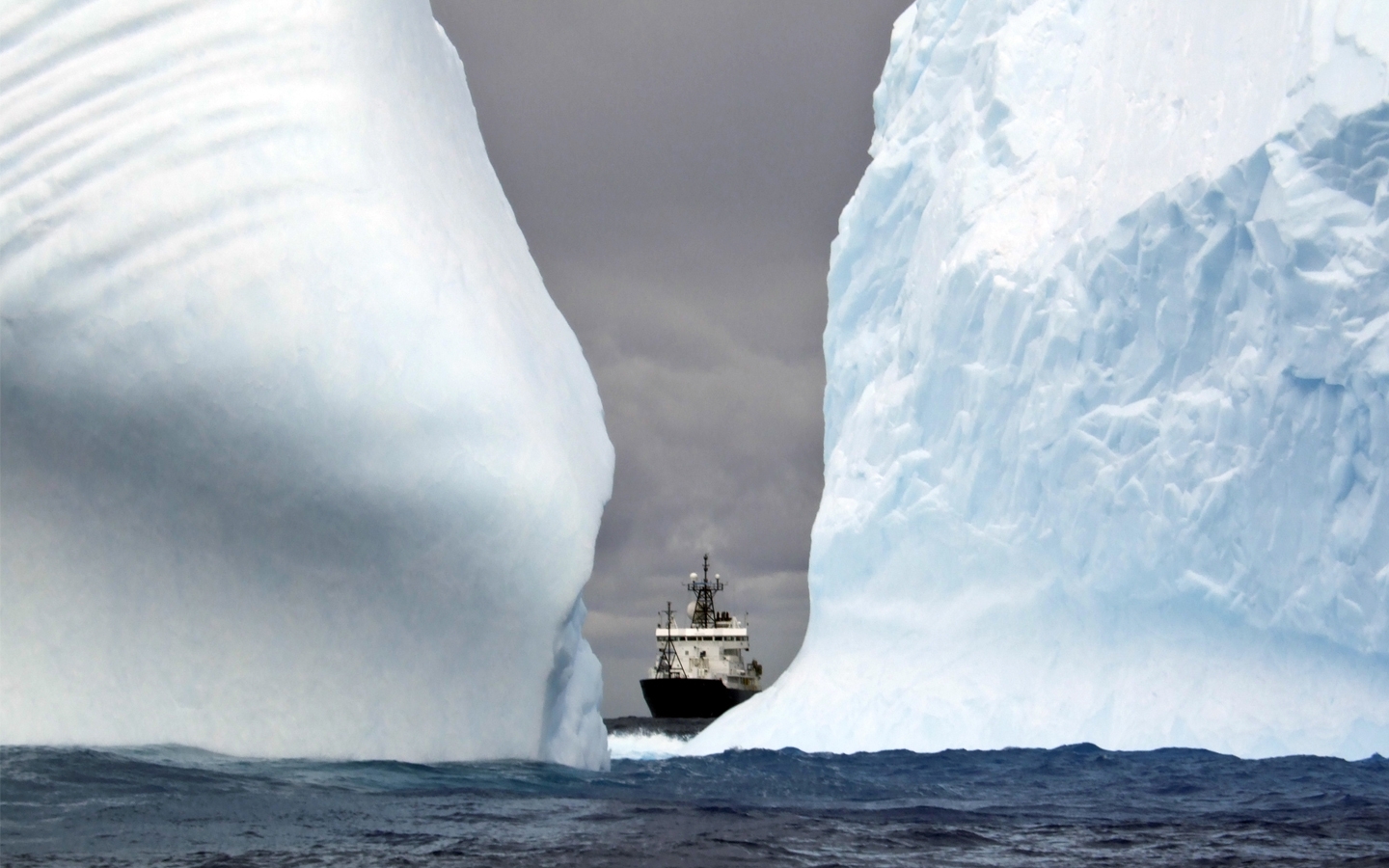Scientists Parse Ocean’s Dynamic Role in Climate Change

The research vessel Roger Revelle during the first DIMES voyage in 2009, photographed from a raft.
Uriel Zajaczkovski
In January 2010, a crew of scientists voyaged by ship from the southern tip of Chile into the frigid Antarctic to search for clues to one of the great unknowns of climate change. They planned to crisscross a remote patch of sea near the spot where, a year earlier, another crew had injected a tankful of an inert chemical one mile below the surface. The new crew had seven weeks of funding and good weather to sample the seawater throughout the region and discover where the chemical went.
By mapping its spread over the course of the year, the scientists hoped to disentangle the forces that drive the circulation of the Southern Ocean — one of the most important, but least understood, regulators of Earth’s climate.
But four days from port, the ship’s captain died in the night. “There was a lot of confusion,” said Angel Ruiz-Angulo, a scientist on board. “Eventually, they said he died of heart failure.” Out of helicopter range, the crew had no choice but to put the captain’s body in a refrigerator designed for seawater samples and set course through gale-force winds for Punta Arenas, Chile, with the first mate at the helm. On shore, a short service was held, and the ship was examined. Then the scientists quickly returned to sea.
“It was a somber mood,” said Jim Ledwell, an oceanographer with Woods Hole Oceanographic Institution and chief scientist on the expedition. “He had been with the crew a long time.” But there was little time to reflect. With only five weeks to collect data, Ledwell formulated a plan to reduce the number of stops the ship would make, focusing on the most essential sampling locations.
“Jim managed to handle everything very well. The results were as good as they could have been otherwise,” Ruiz-Angulo said. The data are now part of emerging models that are expected to yield a far more accurate picture of future climate change.
“What happens in the Southern Ocean has a profound impact on what the climate projections are 100 years from now,” said Sarah Gille, an oceanographer at the Scripps Institution of Oceanography in San Diego and, along with Ledwell and others, a principal investigator on the Diapycnal and Isopycnal Mixing Experiment in the Southern Ocean, or DIMES campaign. Earth is warming, and variations in climate models affect whether scientists predict an increase of, for example, 2, 4 or 6 degrees Celsius (3.6, 7.2 or 11.8 degrees Fahrenheit) a century from now, Gille said — “enough to actually make a real difference in climate and how much you worry about future climate change.”
At the high end of that range, many coastal and arid regions that are currently home to humans would become uninhabitable, subsumed by sea or desert.
Sea Changes
The Southern Ocean plays an outsize role in containing global warming, swallowing an estimated 10 percent of the heat-trapping carbon dioxide that humans pour into the atmosphere. But the ribbon of water surrounding Antarctica may be absorbing less carbon than it used to, a study in the journal Science suggested in February, possibly because strengthened winds are dredging up more sunken carbon from the seafloor and causing it to saturate the surface waters. Because subtle changes can trigger a feedback loop in fluid dynamics, some researchers think the Southern Ocean could eventually switch from absorbing carbon dioxide to emitting it (as may have occurred in the ancient past), which would further escalate global temperatures.
The Southern Ocean has a powerful effect on Earth’s climate because it “provides a connection between the atmosphere and the deep ocean,” said Andrea Burke, a marine chemist doing postdoctoral work at California Institute of Technology who is not involved with DIMES. It circles Antarctica, enabling surface winds to drive it eastward in a continuous loop. The Antarctic Circumpolar Current, as it’s called, has an average or “mean flow,” while buildups of surplus energy erupt into eddies — circular currents tens of miles across that stir the water and, in a feedback process, reinforce the mean flow.
Because cold, dense water is farther below the ocean’s surface toward the equator than near Antarctica, ocean layers of constant density slope upward as one moves north to south across the Southern Ocean. Eddies and the mean flow draw water from the depths to the surface along these southward inclines, then drive it down again as it moves northward — a conveyor belt called an “overturning circulation” that scientists say is the biggest on Earth.
These circulations conspire to make the Southern Ocean a remarkably efficient absorber of greenhouse gases, which are swallowed at the surface and channeled to the seafloor. And as a driver of global ocean currents, the Southern Ocean bolsters the impact of the other oceans on the climate, too.
But because of the complexity of ocean dynamics, climate change effects — strengthening surface winds (also caused by the hole in the ozone layer) and the 0.8 degrees C (1.4 degrees F) rise in average global temperatures since the start of the Industrial Revolution, for example — could drastically alter these circulations decades from now.
“Understanding the feedbacks between the mean flow and the eddies is critical to understanding future climate change,” said Emily Shuckburgh, an applied mathematician at the British Antarctic Survey and a DIMES principal investigator whose research over the past decade has highlighted the complex role played by eddies in ocean dynamics.
Despite their importance in driving large-scale ocean circulations, eddies are not fully represented in climate models like those used by the Intergovernmental Panel on Climate Change (IPCC), Shuckburgh said. Those models are created by solving an interrelated system of equations at every point on a grid representing Earth. The finer the grid, the more geographic features a model can take into account and the more precisely it can predict the flow of materials such as heat and CO2, which directly impact climate. But ocean eddies are too small for even the most powerful supercomputers to resolve in models of the entire planet. Because these unresolved features strongly influence the behavior of larger features, such as the mean flow and the overturning circulation of the ocean, leaving them out of the picture creates large uncertainties in the models.
The working solution is to “parameterize” ocean eddies by incorporating a term into the equations used in coarse-grained climate models that attempts to capture their net effect. For years, this eddy parameter has been estimated based on satellite measurements and scattered temperature records. “We looked at this and said, ‘This is all great, but no one has ever measured the way that eddies flux heat or CO2. How do we know this has any basis in reality?’ ” Gille explained.
Climate science has suffered from a relative lack of studies of the Southern Ocean “because of its remote location and harsh weather,” Burke said. “This makes the results from the DIMES experiment really useful and unique.”
A Drop in the Ocean
A rare collaboration of oceanographers, chemists and applied mathematicians in the United States and United Kingdom, the DIMES experiment was founded to fill the gaps in knowledge of the Southern Ocean. About twice per year since 2009, crews from each side of the Atlantic have taken turns traveling to the bottom of the planet to conduct experiments and collect data at sea, which will later be assimilated into climate models.
It’s a long way from the math department at Cambridge University where Shuckburgh spent much of her career. “You understand much better the errors in the measurement if you’ve actually seen how it’s done,” she said.
During the first voyage, the scientists released 80 kilograms (176 pounds) of an inert compound called trifluoromethyl sulfur pentafluoride, or CF3SF5, from a sled being dragged behind their ship a mile underwater. The molecules serve as a “tracer,” mapping the influence of eddies as they corkscrew through the ocean. In subsequent voyages — the seventh is currently under way and has its own blog — the crews have tracked the spread of CF3SF5 by collecting thousands of water samples.
“We have such amazing sensitivity that we can run the experiment for five years, and we can still see the tracer after it has spread over thousands of miles of ocean,” said Ledwell, who has spent three decades developing the method.
Just like stirring helps disperse milk in coffee, the scientists expect the tracer to spread faster in eddying regions than elsewhere, especially at depths where eddies tend to swirl in place. Throughout the region, the crew released 200 neutrally buoyant floats that can be tracked with acoustics. The floats map the locations and paths of eddies as they drift through the water, and tracer measurements are then compared to this eddy map.
At the ocean surface, Shuckburgh led another float experiment that tested a novel approach to the study of fluid flow. Over the past decade, applied mathematicians led by George Haller, now of ETH Zurich in Switzerland, and others have discovered the mathematics describing rigid barriers that form in fluids called Lagrangian coherent structures. These structures, which are associated with eddies, organize turbulence by repelling fluids from areas known as stable manifolds and shunting them along contours known as unstable manifolds. Shuckburgh used satellite records of the Southern Ocean surface winds to guess the locations of hyperbolic points, where stable and unstable manifolds meet, and released GPS-rigged floats in those spots. “People thought we were mad,” she said.
The floats traced the arms of the hypothesized unstable manifolds almost exactly, lending support to this new conceptual framework for characterizing turbulence.
“I find it remarkable that a relatively low-budget experiment can provide such convincing evidence for the major role played by Lagrangian coherent structures in ocean mixing,” Haller, who was not involved with the experiment, said by email.
In new research forthcoming in the Journal of Physical Oceanography, Haller and his colleagues argue that the theory of Lagrangian coherent structures can be used to locate and characterize eddies more precisely than traditional methods and that eddy-resolving climate models should eventually adopt the technique. Other researchers are using Lagrangian coherent structures to predict the spread of pollutants from oil spills, fluid flow in hurricanes, airplane turbulence and marine animal foraging patterns.
Models of the Future
Ocean modelers on the DIMES team have begun to assimilate the tracer and float data into their models. At the Scripps Institution, Gille’s team will use it to determine boundary conditions: uncertainties such as rainfall, movement of heat through the surface, evaporation and wind speed that can be dialed up and down in the models across a range of values. “By allowing those to vary, we can match the DIMES data and data from other sources,” Gille explained. The values that match the data are then locked in to the model.
Other DIMES researchers are using the data to refine eddy-resolving models of the ocean. The outcome of their simulations will help them tune eddy parameters in climate models of the entire Earth.
“The eddy parameterization that we thought might work does to some extent, but there seem to be serious deficiencies,” said Kevin Speer, a physical oceanographer at Florida State University and DIMES co-principal investigator. “One thing that’s come out very clearly is the enormous effect of seafloor topography on mixing.”
As the Antarctic Circumpolar Current passes over seafloor mountains and ridges, the bumps in its flow propagate upward through the water column. This vertical turbulence in turn interacts with eddying in the horizontal direction. Altogether, the tracer data indicate that vertical mixing of heat and CO2 is 20 times greater in rough-bottomed regions compared with smoother parts of the ocean. “Ultimately, in the next few years, we should be giving climate modelers some suggestions for how to incorporate that inhomogeneity into the mixing,” Ledwell said.
“This is going to be one of the legacies of DIMES,” Speer said.
Other preliminary work by modelers on the DIMES team suggests that eddy-parameterized models accurately portray basic ocean circulation patterns, Gille said, but eddy-resolving models provide more details about where heat is transported and could therefore reveal country-specific impacts of climate change.
The next IPCC report, which comes out in September 2013, will not incorporate findings from the DIMES project in its climate models. But the major modeling centers that are developing models for the following report, Shuckburgh said, are honing the representation of eddy processes in the Southern Ocean with the help of DIMES results.
“There’s reason to hope there will be big improvements in climate modeling,” Ledwell said. “Communication between the modelers and experimentalists is improving. We’re not in our own world; we’re talking to each other more. Some people wear both hats.”
This article was reprinted on Wired.com.



